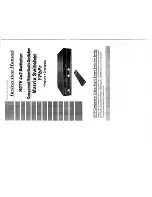
iES26GF
User’s
Manual
UM-iES26GF-1.2.3-EN.docx
Pages 125 of 169
4.MAC-based
Auth.
Unlike port-based 802.1X, MAC-based authentication is not a standard, but
merely a best-practices method adopted by the industry. In MAC-based
authentication, users are called clients, and the switch acts as the supplicant on
behalf of clients. The initial frame (any kind of frame) sent by a client is snooped
by the switch, which in turn uses the client's MAC address as both username and
password in the subsequent EAP exchange with the RADIUS server. The 6-byte
MAC address is converted to a string in the following form "xx-xx- xx-xx- xx-
xx", that is, a dash (-) is used as separator between the lower-cased hexadecimal
digits. The switch only supports the MD5-Challenge authentication method, so
the RADIUS server must be configured accordingly.
When authentication is complete, the RADIUS server sends a success or failure
indication, which in turn causes the switch to open up or block traffic for that
particular client, using the Port Security module. Only then will frames from the
client be forwarded on the switch. There are no EAPOL frames involved in this
authentication, and therefore, MAC-based authentication has nothing to do with
the 802.1X standard.
The advantage of MAC-based authentication over port-based 802.1X is that
several clients can be connected to the same port (e.g. through a 3rd party
switch or a hub) and still require individual authentication, and that the clients
don't need special supplicant software to authenticate. Another advantage of
MAC-based authentication over 802.1X-based authentication is that the clients
do not need special supplicant software to authenticate. The disadvantage is that
MAC addresses can be spoofed by malicious users - equipment whose MAC
address is a valid RADIUS user can be used by anyone. Also, only the MD5-
Challenge method is supported. The maximum number of clients that can be
attached to a port can be limited using the Port Security Limit Control
functionality.
Port State
The current state of the port. It can undertake one of the following values:
Globally Disabled
: NAS is globally disabled.
Link Down
: NAS is globally enabled, but there is no link on the port.
Authorized
: the port is in Force Authorized or a single-supplicant mode and the
supplicant is authorized.
Unauthorized:
the port is in Force Unauthorized or a single-supplicant mode
and the supplicant is not successfully authorized by the RADIUS server.
X Auth/Y Unauth
: the port is in a multi-supplicant mode. Currently X clients are
authorized and Y are unauthorized.
Restart
Two buttons are available for each row. The buttons are only enabled when
authentication is globally enabled and the port's Admin State is in an EAPOL-
based or MAC-based mode.
Clicking these buttons will not cause settings changed on the page to take effect.
Reauthenticate:
schedules a reauthentication whenever the quiet-period of the
port runs out (EAPOL-based authentication). For MAC-based authentication,
reauthentication will be attempted immediately.
The button only has effect on successfully authenticated clients on the port and
will not cause the clients to be temporarily unauthorized.
Reinitialize:
forces a reinitialization of the clients on the port and hence a
reauthentication immediately. The clients will transfer to the unauthorized state
while the reauthentication is in progress.
Содержание iES26GF
Страница 74: ...iES26GF User s Manual UM iES26GF 1 2 3 EN docx Pages 69 of 169 Figure 74 Unaware and C port Port Types...
Страница 75: ...iES26GF User s Manual UM iES26GF 1 2 3 EN docx Pages 70 of 169 Figure 75 S port and S custom Port Types...
Страница 101: ...iES26GF User s Manual UM iES26GF 1 2 3 EN docx Pages 96 of 169 Figure 102 QCE Configuration interface...
















































